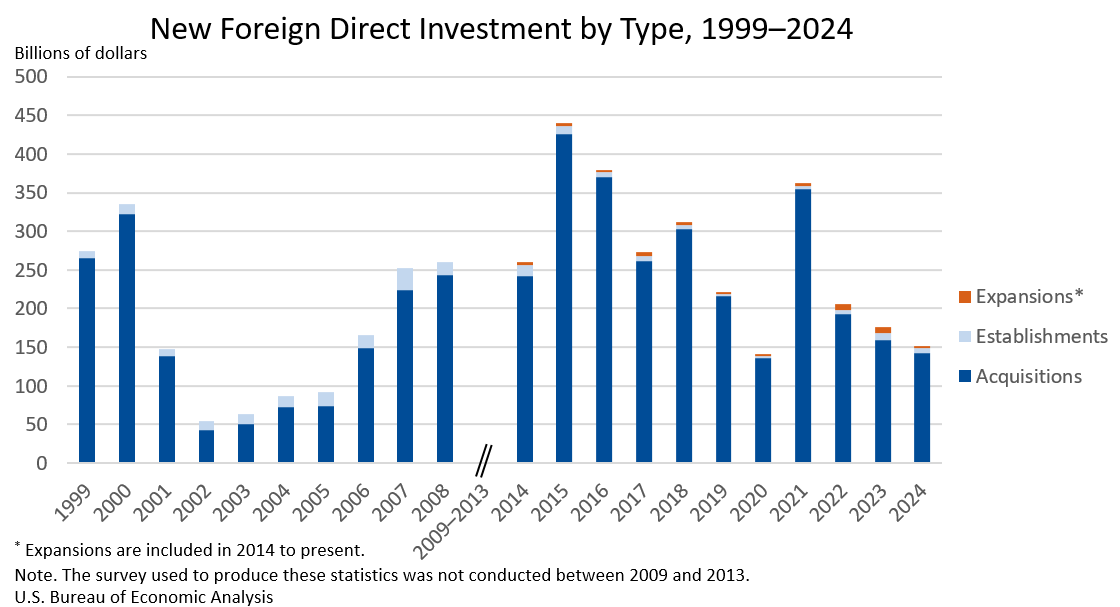Bureau of Economic Analysis
New Foreign Direct Investment in the United States, 2024
Expenditures by foreign direct investors to acquire, establish, or expand U.S. businesses totaled $151.0 billion in 2024, according to preliminary statistics released today by the U.S. Bureau of Economic Analysis. Expenditures decreased $24.9 billion, or 14.2 percent, from $176.0 billion (revised) in 2023 and were below the annual average of $277.2 billion for 2014–2023. As in previous years, acquisitions of existing U.S. businesses accounted for most of the expenditures.
Principal Federal Economic Indicators
Noteworthy
- 2025 News Release Schedule
- Innovation at BEA
- 2025 Annual Updates
- New! Services Trade Data for More Countries
- Data Tool: Trade in Value Added
- Distribution of State Personal Income
- Updated: RIMS II Regional Multipliers
- Arts and Culture
- Space Economy
- FDI Now in State BEARFACTS
- Quick Guide: Price Indexes
The Latest
Personal Income and Outlays, April 2021
Personal income decreased $3.21 trillion, or 13.1 percent at a monthly rate, while consumer spending increased $80.3 billion, or 0.5 percent, in April. Economic impact payments established by the American Rescue Plan Act, declined sharply in April.
Gross Domestic Product, First Quarter 2021 (Second Estimate) Corporate Profits, First Quarter 2021 (Preliminary Estimate)
Real gross domestic product (GDP) increased at an annual rate of 6.4 percent in the first quarter of 2021, reflecting the continued economic recovery, reopening of establishments, and continued government response related to the COVID-19pandemic. The increase was the same rate as the “advance” estimate released in April.
Gross Domestic Product, 1st Quarter 2021 (Second Estimate); Corporate Profits, 1st Quarter 2021 (Preliminary Estimate)
Real gross domestic product (GDP) increased at an annual rate of 6.4 percent in the first quarter of 2021, reflecting the continued economic recovery, reopening of establishments, and continued government response related to the COVID-19 pandemic. The increase was the same rate as the “advance” estimate released in April. In the first quarter, government assistance payments, such as direct economic impact payments, expanded unemployment benefits…
Gross Domestic Product for the U.S. Virgin Islands (USVI), 2019
The estimates of GDP for the U.S. Virgin Islands show that real GDP—GDP adjusted to remove price changes— increased 2.2 percent in 2019 after increasing 1.6 percent in 2018.
The increase in real GDP reflected increases in private fixed investment, exports, and consumer spending. These increases were partly offset by decreases in inventory investment and government spending. Imports, which are a subtraction item in the calculation of…
Gross Domestic Product for the U.S. Virgin Islands (USVI), 2019
The estimates of GDP for the USVI show that real GDP—GDP adjusted to remove price changes—increased 2.2 percent in 2019 after increasing 1.6 percent in 2018. This release also includes the results of a comprehensive update of the territorial economic accounts.
BEA Updates Tool for Economic Impact Studies
How would expanding a community college, building a new factory, or increasing government spending on roads impact your local economy? BEA has a tool that can help answer questions like these.
Local planners, businesspeople, and policymakers use the Regional Input-Output Modeling System to predict the potential economic impacts of a variety of projects and events, even natural disasters like hurricanes. The modeling system, known as…
March 2021 Trade Gap is $74.4 Billion
The U.S. monthly international trade deficit increased in March 2021 according to the U.S. Bureau of Economic Analysis and the U.S. Census Bureau. The deficit increased from $70.5 billion in February (revised) to $74.4 billion in March, as imports increased more than exports. The previously published February deficit was $71.1 billion. The goods deficit increased $3.6 billion in March to $91.6 billion. The services surplus decreased $0.3…
U.S. International Trade in Goods and Services, March 2021
The U.S. monthly international trade deficit increased in March 2021 according to the U.S. Bureau of Economic Analysis and the U.S. Census Bureau. The deficit increased from $70.5 billion in February (revised) to $74.4 billion in March, as imports increased more than exports. The previously published February deficit was $71.1 billion. The goods deficit increased $3.6 billion in March to $91.6 billion. The services surplus decreased $0.3 billion…
Personal Income and Outlays, March 2021
Personal income increased $4.21 trillion, or 21.1 percent at a monthly rate, while consumer spending increased $616.0 billion, or 4.2 percent, in March. Economic impact payments established by the American Rescue Plan Act of 2021, which was enacted on March 11, 2021, were distributed. In addition to presenting estimates for March 2021, these highlights provide comparisons to February 2020, the last month before the onset of the COVID-19…
Personal Income and Outlays, March 2021
Personal income increased $4.21 trillion, or 21.1 percent at a monthly rate, while consumer spending increased $616.0 billion, or 4.2 percent, in March. Economic impact payments established by the American Rescue Plan Act of 2021, which was enacted on March 11, 2021, were distributed.




